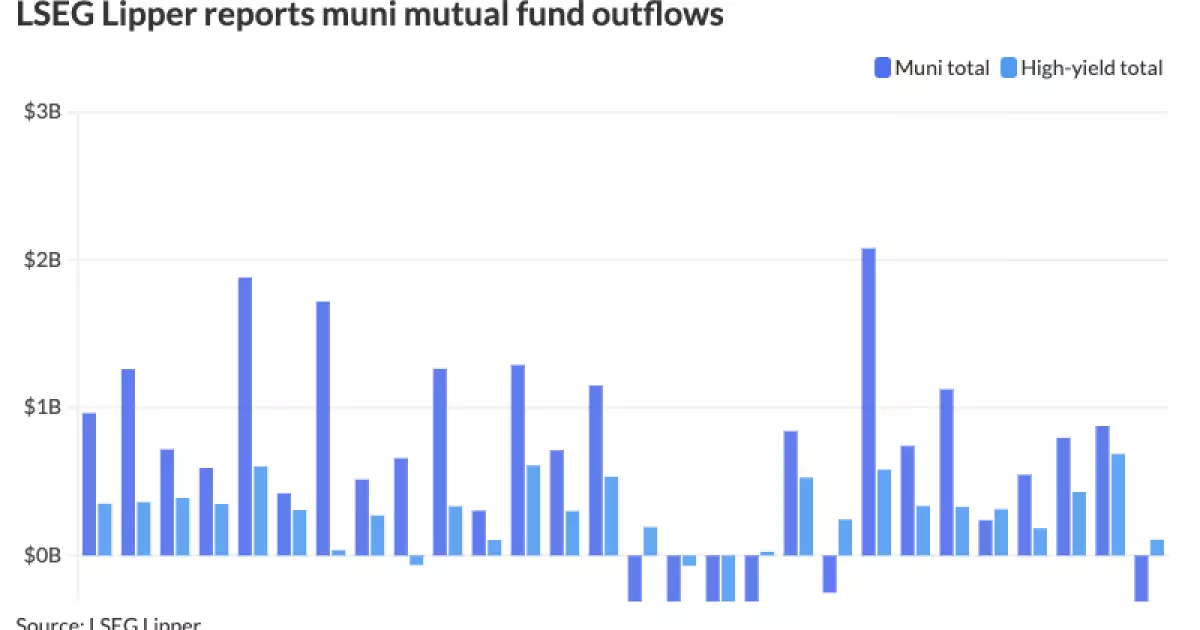The municipal bond market is experiencing turbulence that many investors may find unsettling. While the performance of these bonds has always been topsy-turvy, recent developments have raised eyebrows, particularly as we witness the disarray in the broader economic environment and the challenges arising from rising interest rates and increased supply. With U.S. Treasury yields declining, one would expect municipalities to benefit from a treasurable opportunity. Yet, the reality appears quite the opposite, as the latest data indicates a troubling trend characterized by shrinking demand and deteriorating performance in municipal bonds.
Supply Overruns: The Elephant in the Room
The persistent imbalance of “more supply than demand” is the cardinal issue plaguing the municipal bond market today. As asserted by Kim Olsan, a senior fixed-income portfolio manager at NewSquare Capital, the fundamentals of municipal bonds are not aligned for strong performance when light redemptions and excessive issuance loom over the landscape. This deliberate increase in supply comes as a double-edged sword: while it may cater to specific financing needs, it simultaneously exacerbates the pressure on existing bonds.
The phrase “corrective tone” could encapsulate the market sentiment currently. Yields have retraced significantly, with ten-year AAA bonds reflecting a more than 50% pullback from their previous peaks. This isn’t just a mere statistic; it speaks volumes about investor confidence and the perceived safety of municipal investments. When investors become skittish, the entire landscape shifts toward a precarious state—a situation that no serious bondholder can afford to ignore.
Volatility and Investor Sentiment
Various external factors contribute to this climate of uncertainty and instability. The “no holds barred” policy stance emanating from Washington D.C. is stirring fears of a possible trade war and increasing tariffs, which could have far-reaching consequences for both the domestic and international economies, affecting investor psychology and overall market traction.
Jeff Lipton, a market strategist, indicates that retail investors in particular are sensitive to volatility. Unlike institutional investors, who may hedge against fluctuations, retail investors are often left feeling unnerved. The threat of eliminating the municipal tax exemption adds another layer of complexity, offering a harsh reminder that the sanctity of tax-free bonds is under scrutiny. If such an exemption were to be repealed, the appetite for municipal bonds could dwindle dramatically, decreasing their attractiveness for both retail and institutional investors alike.
Real-World Impact: Infrastructure and Tax Spending
How do these shifts in the municipal bond market intersect with the real world? Our nation’s infrastructure is already performing below the standards necessary for societal safety and security. The growing trend of increasing interest rates creates a scenario where investment in critical infrastructure could stall, worsening an already urgent situation.
It is indeed ironic that the same financial instruments designed to bolster state and local infrastructure could inadvertently become impediments to progress due to insufficient investor demand. When municipalities are unable to launch essential public projects due to soaring yields or limited market interest, society at large suffers.
Looking at this through a center-right liberal lens, one might argue that it is the federal government’s responsibility to provide a more stable economic environment conducive to proactive municipal funding. Eliminating the municipal tax exemption would not only undermine local governments’ abilities to finance projects effectively but could also exacerbate tax burdens on already strained public finances. There is a pressing need for a balanced approach towards fiscal policies, focusing on strengthening beneficial initiatives rather than crippling them with heavy-handed reforms.
Supply Chain Dynamics: The Role of Institutional Investors
Interestingly, despite the diminishing appeal of muni bonds in this volatile environment, some state issuers maintain confidence. As certain deals have been digested well, it appears institutions are still willing to navigate these treacherous waters—though their interest may not be as fervent as it once was. This raises a pointed question: will institutional investors continue to participate when economic circumstances seem so stacked against them?
Increased issuances could lead to a dilution of quality, meaning that only the most attractive bonds will attract capital. If state issuers are not careful, they risk alienating those institutional players who have historically provided the lifeblood capital that fuels infrastructure projects. One can only hope that wisdom prevails in managing these issuances, keeping in mind the broader ramifications of investor sentiment.
As the dynamics of the municipal bond market continue to evolve, it is imperative for stakeholders to acknowledge these challenges before they spiral into a full-blown crisis. Keeping a watchful eye on both domestic policies and market indicators is not just prudent, but essential for navigating these uncertain waters.

